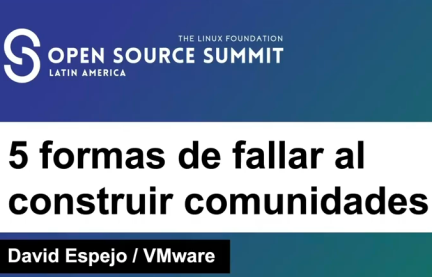
Videos from the recent Community Leadership Conference are now online for anyone interested in learning about interacting with or integrating into Free and Open Source Software communities.
For IT departments looking to work with developer communities, one interesting presentation (in Spanish) was David Espejo’s 5 Ways to Fail at Building Communities, namely:
- “Not communicating decisions” - Open source projects generally offer transparency, but they also expect transparency from others. A lack of transparency can be seen as an attempt to put a barrier between you and the developer community, and it’s logical that this will have consequences for trying to build a relationship.
- “Focussing on the wrong metrics” - A lot of projects use online Git repositories but the basic metrics for the activity or popularity of a project can become distorted. Espejo recommends taking the time to look at more advanced metrics such as Chaoss. (For another example of how Chaoss is used, this time to detect neglected modules in a software ecosystem, see Open Source Newbie Experience - CHAOSScon EU 2022)
- “Inconsistency” - Espejo here focuses on maintaining at least a basic effort being put into a project. Similar to the first point, this is because members of an open development team are peers. You might have a contract with some part of the developer team, but you’re unlikely to have a contractual relationship with the community as a whole, so if you want to grow the relationship with the whole community it’s good to show you’re interested.
- “Focussing on the project” - Every piece of software exists in an ecosystem, both in the development stage where it depends on a toolchain and also in the implementation stage when it will have to be compatible or share data with other pieces of software.
- “Not having a plan” - There are some famous Open Source packages that have developed organically with very little planning, but it’s a small number, and people looking at the Linux kernel, for example, which started as a fun project, shouldn’t lose sight of the reality that it has taken thousands of people and some very organised companies to get Linux to where it is today. The “fun project” stage with no plan was only a tiny part of the project’s history.
There were, of course, many other interesting presentations. Below is a selection, in English:
- From Traditional to GitOps: A Tale of Modernizing Two Goverment Institutions in One Year
- It All Starts With a Smile: How To Foster a Sense of Belonging in Remote Teams - Eleni Katsoula
- Dev Team Metrics that Matter - Avishag Sahar, LinearB
- Policy as [versioned] Code - Chris Nesbitt-Smith, UK Government
- Building & Supporting Open Source Communities Through Metrics - Georg Link & Emilio Galeano Gryciuk
- How to Grow & Mentor an Open Source Community & Achieve Collaboration with Over 170 Listed Corporations
The Community Leadership Conference was part of the Linux Foundation's Open Source Summit, which included many other topics. On the technical side, with many public administrations interested in sovereign Cloud services, there were technical presentations that may be of interest:
- Introduction to the Native Cloud Ecosystem and KCNA Exam Preparation
- Getting Involved Students Into the CNCF Cloud Native Ecosystem - Sergio Méndez
- SOAR with Postee: Automated Incident Response for Cloud Native Risks
- How Geo-Distributed Apps Use Global Cloud Infra for Speed and Compliance - Denis Magda, Yugabyte
- LF Live Webinar: GraphQL to Simplify Data Access for Cloud Native
References
Login or create an account to comment.

